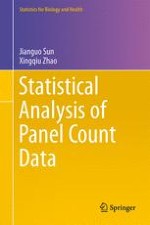2013 | OriginalPaper | Chapter
6. Regression Analysis of Panel Count Data II
Authors : Jianguo Sun, Xingqiu Zhao
Published in: Statistical Analysis of Panel Count Data
Publisher: Springer New York
Activate our intelligent search to find suitable subject content or patents.
Select sections of text to find matching patents with Artificial Intelligence. powered by
Select sections of text to find additional relevant content using AI-assisted search. powered by
